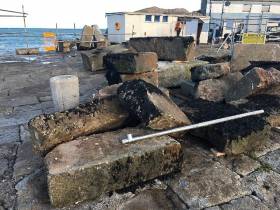Displaying items by tag: Heritage Harbour
Bulloch Harbour's Bicencentary Talks Continue Against Backdrop of Storm Damaged Breakwater
#Bullock200 - The scenic south Dublin Bay harbour at Bulloch, Dalkey, is where construction on the stone-cut structure began in the winter 1818/19 and to celebrate the 200th anniversary a series of talks as Afloat previously highlighted will continue to May 2019.
The famous Dalkey landmark, used locally sourced granite to built the harbour for the Ballast Board (now managed by Dublin Port Company). The primary purpose of the harbour was to ship the granite from their quarry on Harbour Road to construct the city quays.
The present walls were built over the breakwater of the medieval fishing port in the tidal rocky creek at the foot of Bullock Castle. See previous coverage photo presenting the harbour in more sequal times! compared to the recent scene as depicted above.
Organisers of the monthly 'Bullock 200' lecture talks (p.17), the Bulloch Harbour Preservation Association (BHPA) and Dublin Port Company will be held in the Dalkey Castle & Heritage Centre.
Admission is free but places should be pre-booked through the Heritage Centre by emailing: [email protected]
Tuesday 4 December 8pm - The History and Heritage of Bullock Harbour
Rob Goodbody, Historic Building Consultant & Local Historian
Tuesday 22 January 8pm -The Building of Bullock Harbour
Elizabeth Shotton, Associate Professor, UCD School of Architecture, Planning & Environmental Policy
Tuesday 12 February 8pm - Bullock Harbour into the Future; Monitoring and Repairs
Eamon McElroy, Port Engineer, Dublin Port Company
Tuesday 12 March 8pm - Port Collections; History of the Port and the Port Archive
Lar Joye, Port Heritage Director, Dublin Port Company
Tuesday 9 April 8pm - Dublin Bay Biosphere
A Panel Discussion
Tuesday 9 May 2019 - Hugh Leonard Walk
with Danielle Keyes-Byrne
The talks are been supported by the Dalkey Community Council, Dalkey Tidy Towns and the Dalkey Castle & Heritage Centre.
As for the Dublin Port Company update on Bullock Harbour Storm Damage (Notice to Mariners No. 31) click here. As mentioned above in the photo-caption, repairs work to the harbour's main pier breakwater began last month and is due to be completed at the end of January 2019.
For much more on the history of the harbour and present day initiatives, among them the up-keep and maintenance of Bulloch (or spelt Bullock) Harbour, between the BHPA, DPC and DTT over the past couple of years click here.
Bullock Harbour, Dalkey Celebrates Bicentenary With Lecture Series
#Bullock200 - While taking a stroll at Bullock Harbour on Dublin Bay, a poster erected next to the former premises of Western Marine, highlights a lecture series celebrating the bicentenary of the landmark gem neighbouring Dalkey, writes Jehan Ashmore.
The scenic stone-cut charm of Bullock Harbour, this winter marks 200 years since construction began in 1818/19 by the Ballast Board (now Dublin Port Company) which still manages the small working harbour on the southern shores of Dublin Bay. The harbour is home to inshore fishing craft, the Dalkey Sea Scouts, a seasonal boat-hire fleet for anglers and is a popular spot for kayakers to embark from a slipway. In addition the attractive maritime setting draws an attentive audience of tourists.
Such present day use is in stark constrast to the origins behind the Ballast Board's reason in building the harbour. The principle purpose for its existance was to enable loading locally quarried granite rock to be shipped across Dublin Bay for constructing the capital quays.
The harbour's piers at Bullock were built over a previous breakwater of the medieval fishing village port, tucked in a tidal rocky creek at the foot of Bullock Castle. The Cistercian monks held lucrative fishing rights that came with the land though this had to be to protected from tribes in Wicklow.
The Castle remains intact and has commanding views overlooking the bay to Sandycove, Dun Laoghaire Harbour, the South Wall breakwater of Dublin Port and Howth Peninsula.
Bullock's Bicentenary Lecture Series
According to DPC's facebook, thanks was made to those who attended this week the first of six Bullock Harbour Bicentenary Lecture Series (to May 2019) held in the Dalkey Castle & Heritage Centre.
The inaugural lecture organised in partnership between Bullock Harbour Preservation Association (BHPA) and Dublin Port focused on the history, expansion and role of the port since 1707 and looking at the close links with the capital city.
The next lecture lined up in the Dalkey Castle & Heritage Centre will be held on:
Tuesday, 4 December at 8pm - The History and Heritage of Bullock Harbour
Speaker: Rob Goodbody, Historic Building Consultant & Local Historian
Further details of the remaining lectures will be posted shortly on Afloat.ie
Admission is free to attend the lectures but places should be pre-booked in advance with the DC&HC by emailing: [email protected]
The lectures have been supported by the Dalkey Community Council, Dalkey Tidy Towns and the Dalkey Castle & Heritage Centre





























































